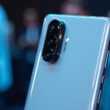In a notable advancement in the storage industry, Biwin Technology has introduced a new player to the solid-state drive (SSD) market: the Mini SSD. This compact storage device-smaller than a British pound coin-promises to redefine portability and durability in the world of digital storage.
Zooming In
In today’s fast-paced tech environment, the demand for compact yet powerful storage solutions has never been higher. MicroSD cards have long dominated this niche, offering portability and convenience despite their limited speed and durability. Biwin’s Mini SSD aims to fill this gap by coupling small size with high performance, directly challenging the status quo established by slower storage solutions.
Technical Specifications and Features
Biwin’s Mini SSDs are remarkable not just for their size, measuring only 15 x 17 x 1.4 mm, but for their impressive specs. Available in capacities ranging from 512 GB to 2 TB, these drives offer read speeds up to 3,700 MB/s and write speeds of 3,400 MB/s. While these numbers may not eclipse those of Gen 4 or Gen 5 SSDs, they significantly outperform the fastest V90-rated MicroSD cards, which top out at approximately 300 MB/s.
Additionally, the Mini SSD is built to endure: it’s IP68-rated, ensuring it’s both dust-resistant and capable of withstanding immersion in water up to a meter deep. It also boasts shock-resistant construction, able to survive drops from heights up to three meters, making it an ideal choice for use in rugged environments or mobile tech.
Market Implications and Challenges
The introduction of the Mini SSD is a strategic move by Biwin to capture a segment of the market that desires both compactness and speed. However, the transition from concept to widespread adoption requires industry support. The Mini SSD’s design necessitates a proprietary socket, meaning device manufacturers will need to integrate this new format, which is a formidable barrier to overcome given the entrenched position of MicroSD technology.
Yet, there are signs of adoption. The GPD Win 5, a handheld gaming device, and the forthcoming OneXPlayer SuperX are among early adopters of this technology, including Mini SSD slots to cater to users seeking advanced storage solutions.
Looking Ahead
Observers will be keen to watch whether major manufacturers join the Mini SSD movement. If Biwin can forge alliances with key industry players, the Mini SSD could potentially see broader use in mobile phones, tablets, and other portable devices. However, the path is fraught with challenges. Shifting an established market takes time and significant effort, and the Mini SSD needs to prove its worth in day-to-day applications.
In summation, the release of Biwin’s Mini SSD marks an exciting step forward in SSD design, offering hope that future devices could benefit from faster, more resilient storage options. Whether this will become a mainstream trend or remain a niche innovation will depend largely on industry uptake and consumer demand in the years to come.








